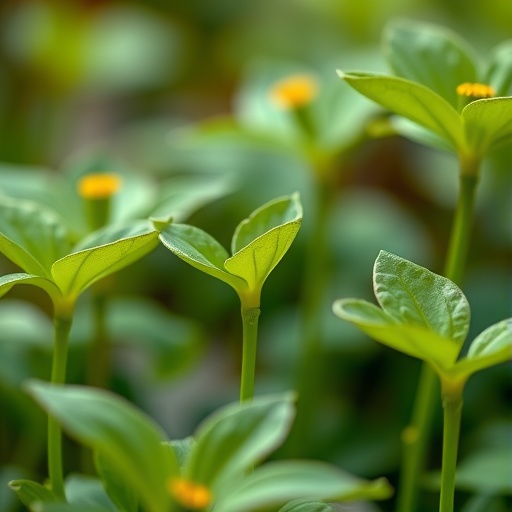In a groundbreaking study that sheds new light on how plants maintain and restore their essential protective barriers, researchers have uncovered a sophisticated mechanism by which vascular plants monitor the integrity of their outer layers using gaseous signals. The latest work reveals that plants, specifically Arabidopsis thaliana, detect breaches in their barrier tissues by sensing the diffusion of gases such as ethylene and oxygen through wounds, which in turn triggers the re-establishment of these barriers. This discovery not only expands our understanding of plant resilience but also hints at intricate surveillance systems akin to those found in more complex organisms.
Plants face a constant barrage of environmental challenges, including physical injuries and pathogen invasions, which compromise the integrity of their outer protective layers. Traditionally, the plant epidermis coupled with specialized cuticular layers has been recognized as the frontline defense, while periderm and suberized cells provide secondary protection typically in roots and stems. However, the ability of plants to monitor and promptly seal these breaches to preserve their internal homeostasis remained poorly understood—until now.
The study focused on the inflorescence stem of Arabidopsis, a model system that naturally lacks periderm and suberized layers but relies heavily on its epidermis and cuticle. When researchers inflicted longitudinal wounds on these stems, they observed a remarkable induction of two genes, PER15 and PER49, both associated with periderm formation, adjacent to the wound site within just one day after injury (1 dai). By four days post-injury, a new suberized cell layer—resembling a wound-induced phellem—had formed, effectively re-establishing the damaged barrier.
.adsslot_y28PzSFjfh{width:728px !important;height:90px !important;}
@media(max-width:1199px){ .adsslot_y28PzSFjfh{width:468px !important;height:60px !important;}
}
@media(max-width:767px){ .adsslot_y28PzSFjfh{width:320px !important;height:50px !important;}
}
ADVERTISEMENT
Intrigued by these findings, the research team investigated the underlying signaling processes prompting such rapid barrier restoration. They hypothesized the existence of a gas-mediated surveillance system, whereby the diffusion of molecules like ethylene and oxygen through the damaged tissues serves as an alert signal to trigger repair mechanisms. To test this, the wounds were sealed immediately after infliction using lanolin or Vaseline, substances known to prevent gas exchange.
The results were striking: sealing the wounds inhibited PER15 gene induction and blocked the formation of the suberized cell layer, clearly demonstrating that the diffusion of gases through the wound site is critical for activating the repair response. Moreover, direct measurements confirmed that wounded stems released significantly higher levels of ethylene compared to undamaged controls, suggesting ethylene as a potential signaling cue.
To further dissect the role of oxygen, the study examined markers of hypoxia signaling, such as the expression of PCO1 and PCO2. Contrary to root tissue responses, hypoxia-related gene expression was unaffected in the injured stems, and mutant plants deficient in this pathway did not exhibit abnormalities in barrier restoration. This finding ruled out hypoxia signaling as a primary trigger in the stem wound response, shifting the spotlight entirely to ethylene and perhaps other gasses or volatile compounds.
Despite the apparent significance of ethylene emission, genetic analyses revealed that plants with mutations in key ethylene signaling components, such as ein2-1 and etr1-3, still developed suberized protective layers after stem injury. This intriguing paradox suggested that while ethylene diffusion is important, it might not act alone. The possibility emerged that other gaseous or volatile molecules, diffusing through the wound, collectively contribute to the establishment of a fully functional barrier.
To localize the ethylene response at the cellular level, researchers utilized an RPS5A:erVenus-EBF1UTR reporter line, a sensitive marker for ethylene signaling activity. In intact wounds, a robust increase in ethylene-responsive signals was evident near the injury site by two days after injury. Sealing wounds with Vaseline substantially diminished this response, again emphasizing the necessity of gas diffusion in the signaling cascade.
Collectively, these findings build a compelling narrative that plants dynamically survey the status of their protective barriers by monitoring the diffusion patterns of gases at injury sites. This gas-mediated sensing constitutes a novel form of “intactness surveillance” regulating the rapid redeployment of suberized layers to reseal wounds effectively.
The implications of this discovery extend well beyond fundamental plant biology. Understanding how plants orchestrate barrier repair can inform strategies for engineering crops with enhanced resilience to mechanical damage and pathogen ingress. Additionally, the notion of gaseous surveillance draws fascinating parallels to immune defense mechanisms in animals, offering a new conceptual framework for interkingdom comparisons.
Moreover, this study sets the stage for future exploration into the identities of the full suite of gaseous and volatile molecules involved, as well as the molecular sensors plants use to detect these changes atmospherically near their surface cells. The apparent redundancy and complexity revealed by the lack of obvious phenotypes in ethylene pathway mutants imply the existence of as yet unknown signaling molecules or cross-talk pathways fine-tuning this essential response.
The precision with which plants manage the repair of their protective barriers underscores an evolutionary sophistication that has enabled their survival across diverse and often hostile environments. By leveraging the simple yet elegant principle of gas diffusion blockage, plants can convert the passive physical property of permeability into an active sensing and response system, showcasing nature’s ingenuity.
As this research unfolds, it invites a broader reconsideration of how plants interact with their immediate microenvironment, highlighting the importance of non-contact signaling and molecular gas exchange in maintaining physiological integrity. Given the ubiquity of barrier tissues and the universality of ethylene as a plant hormone, these findings likely represent a widespread, conserved strategy across vascular plants.
In summary, this study by Iida et al. offers a rare glimpse into the gas-encoded language plants use to monitor and restore their crucial protective boundaries. Through cleverly designed injury experiments combined with genetic and molecular analyses, they reveal a novel, gas-mediated surveillance mechanism fundamental to plant survival.
The discovery invites exciting new questions: Could modulation of gas diffusion pathways be exploited to enhance crop robustness? Are there additional gaseous signals yet to be identified? And what molecular sensors underlie this elegant detection system? This pioneering work propels the field forward, illuminating how plants quietly perceive and defend their outer worlds using the invisible yet powerful cues of chemistry in the air.
Subject of Research: Plant barrier integrity monitoring and re-establishment via gas diffusion signaling in Arabidopsis inflorescence stems.
Article Title: Plants monitor the integrity of their barrier by sensing gas diffusion.
Article References:
Iida, H., Abreu, I., López Ortiz, J. et al. Plants monitor the integrity of their barrier by sensing gas diffusion. Nature (2025). https://doi.org/10.1038/s41586-025-09223-4
Image Credits: AI Generated
Tags: Arabidopsis thaliana researchenvironmental challenges for plantsethylene and oxygen sensinggas diffusion in plantsmonitoring plant woundsplant barrier integrityplant epidermis and cuticleplant resilience mechanismsplant surveillance systemsprotective layers in plantssealing breaches in plant tissuesvascular plant defenses





